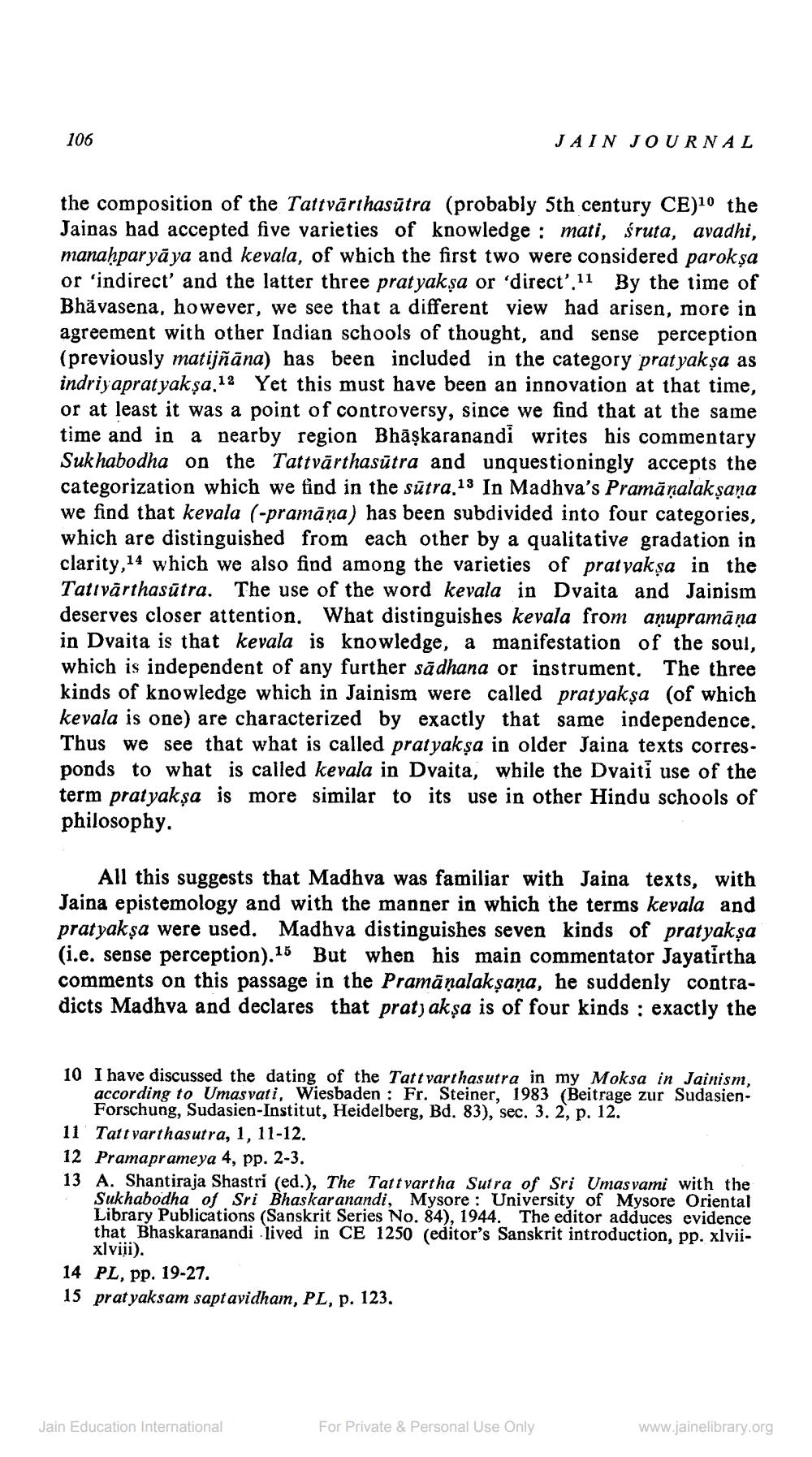Book Title: Jain Journal 1991 01 Author(s): Jain Bhawan Publication Publisher: Jain Bhawan Publication View full book textPage 8
________________ 106 JAIN JOURNAL the composition of the Tattvārıhasūtra (probably 5th century CE)10 the Jainas had accepted five varieties of knowledge : mati, śruta, avadhi, manaḥparyāya and kevala, of which the first two were considered parokşa or 'indirect' and the latter three prat yakṣa or direct'.11 By the time of Bhāvasena, however, we see that a different view had arisen, more in agreement with other Indian schools of thought, and sense perception (previously matijñāna) has been included in the category pratyak sa as indriyapratyakşa,12 Yet this must have been an innovation at that time, or at least it was a point of controversy, since we find that at the same time and in a nearby region Bhāṣkaranandi writes his commentary Sukhabodha on the Tattvārthasūtra and unquestioningly accepts the categorization which we find in the sūtra 13 In Madhva's Pramāņalakşaņa we find that kevala (-pramāņa) has been subdivided into four categories, which are distinguished from each other by a qualitative gradation in clarity, 14 which we also find among the varieties of pratyakșa in the Tatīvārthasūtra. The use of the word kevala in Dvaita and Jainism deserves closer attention. What distinguishes kevala from aņupramāņa in Dvaita is that kevala is knowledge, a manifestation of the soul, which is independent of any further sādhana or instrument. The three kinds of knowledge which in Jainism were called pratyakșa (of which kevala is one) are characterized by exactly that same independence. Thus we see that what is called pratyakṣa in older Jaina texts corresponds to what is called kevala in Dvaita, while the Dvaiti use of the term pratyakșa is more similar to its use in other Hindu schools of philosophy. All this suggests that Madhva was familiar with Jaina texts, with Jaina epistemology and with the manner in which the terms kevala and pratyakşa were used. Madhva distinguishes seven kinds of pratyakşa (i.e. sense perception).15 But when his main commentator Jayatirtha comments on this passage in the Pramāṇalakşaņa, he suddenly contradicts Madhva and declares that prat) akşa is of four kinds : exactly the 10 I have discussed the dating of the Tatt varthasutra in my Moksa in Jainism, according to Umas vati, Wiesbaden : Fr. Steiner, 1983 (Beitrage zur Sudasien Forschung, Sudasien-Institut, Heidelberg, Bd. 83), sec. 3. 2, p. 12. 11 Tatt varthasutra, 1, 11-12. 12 Pramaprameya 4, pp. 2-3. 13 A. Shantiraja Shastri (ed.), The Tattvartha Sutra of Sri Umas vami with the Sukhabodha of Sri Bhaskaranandi, Mysore : University of Mysore Oriental Library Publications (Sanskrit Series No. 84), 1944. The editor adduces evidence that Bhaskaranandi lived in CE 1250 (editor's Sanskrit introduction, pp. xlvii xlviii). 14 PL, pp. 19-27. 15 prat yaksam saptavidham, PL, p. 123. Jain Education International For Private & Personal Use Only www.jainelibrary.orgPage Navigation
1 ... 6 7 8 9 10 11 12 13 14 15 16 17 18 19 20 21 22 23 24 25 26 27 28 29 30 31 32 33 34 35 36 37 38 39 40 41 42 43 44 45 46 47
